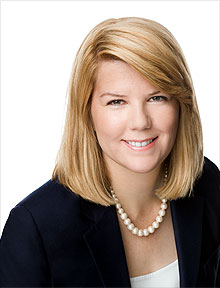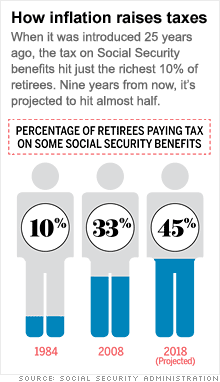Stop soaking the not-so-rich
These tax provisions aimed at wealthy Americans have become something else entirely: burdens on the upper middle class.
 |
| Janice Revell is the author of "Revell's rules for retirement" for CNNMoney's Retirement guide |

(Money Magazine) -- President Obama has said he'd like to lower the tax load on families making less than $250,000 and to raise it on people who make more than that.
This concept is hardly new; all kinds of taxes aimed at the highest-earning Americans have been enacted in the past. But many of those provisions haven't been adjusted for inflation for decades.
The result: They have morphed into traps for middle- and upper-middle-income earners - and Congress hasn't done a thing about it. Check out these three examples.
In 1984, when the Social Security system faced a funding crisis, Congress enacted a law to make the wealthiest recipients pay income taxes on their benefits. Specifically, up to 50% of Social Security benefits became taxable when half of them, plus a retiree's other income - including retirement-plan payouts and investment income - exceeded $25,000 a year ($32,000 for couples.)
Back then, only about 10% of retirees had incomes that topped those levels (In 1994, yet another level of Social Security taxation was put in place, so that 85% of your Social Security benefits became taxable if half of your Social Security benefit plus your "other" income topped $34,000, or $44,000 as a couple).
Today the Social Security tax still kicks in at $25,000. The result: Thirty-three percent of retirees are now paying it, and 45% are expected to be doing so less than a decade from now (see the chart).
Congress designed the AMT in 1969 to prevent the super-rich from taking too many deductions. In 1970 the law affected just 20,000 taxpayers.
But the AMT's income thresholds have never been adjusted for inflation. True, each year Congress passes legislation known as the "AMT patch" to limit the number of middle-class Americans who get hit. But the patch has holes. By 2007 a whopping 4.1 million people owed the tax, according to estimates by the Tax Policy Center - including 800,000 people who made less than $200,000. Of that group, 125,000 made less than $100,000.
In fact, today the very richest Americans make up a tiny sliver of those who get zapped. In 2007, says the Tax Policy Center, only 4.9% of all AMT payers had incomes of $1 million or more.
As you probably know, if the realized capital losses on your investments far exceed your gains in any one year, you can carry them forward to reduce your ordinary income in the future - to the tune of $3,000 a year, after you've applied them against any future capital gains. What you might not know is that the $3,000 limit hasn't budged since 1978.
If the limit were adjusted for inflation, it would be about $10,000 today. To the super-rich, whether the limit is $3,000 or $10,000 doesn't make much difference. But to plenty of middle-class folks who got hammered by the market, it sure does.
Now, I'm not arguing that any of this can be fixed cheaply, or even that it can be fixed completely, given the burgeoning budget deficit. But I do suggest that once the financial crisis passes and Congress and the Obama administration start serious discussions about the tax code, they give these outdated provisions a good hard look. ![]()


